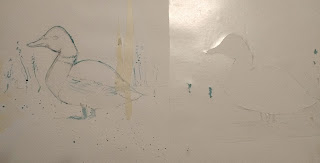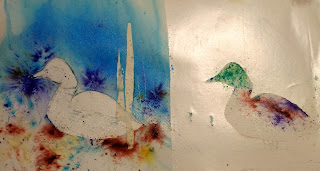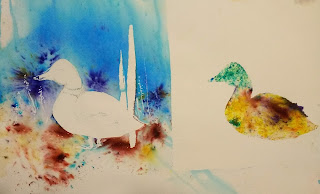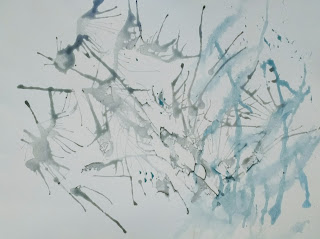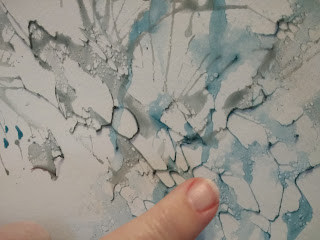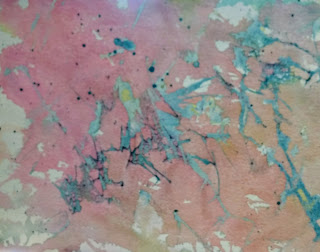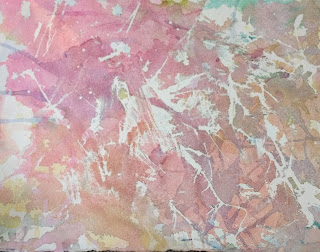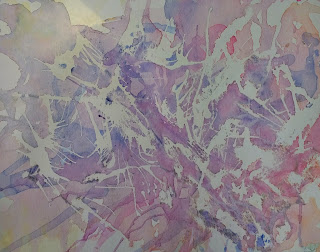FIRST, A BRAG OF THE FINISHED/ALMOST FINISHED PIECES FROM CLASSWORK:
PAINTING SKIN TONES
There are as many ways to create skin tones as there are people, I think. Every artist has his own methods of doing things. I'm just going to show a few ways that have worked for me. I did not invent any of these, and where I remember names, I will give credit to the artist or book that I have found useful.
One of the simplest ways to achieve a skin tone is through glazing. (Glazing is merely applying color, letting it dry, and then applying more color over it, in thin layers.) Let the following picture illustrate,
using just three colors: new gamboge, permanent rose, and cobalt.
First I glazed over all the face with yellow, keeping it more watered down on lighter areas, darker in areas of shadow. After that dried, I glazed over the RIGHT HALF with permanent rose. (I left the other half so you could see the first step.) After the permanent rose dried, I used cobalt in some of the shadow areas. You can glaze these colors over and over again without getting muddy.
I don't usually do it this way, but I do glaze toward the end of the process.
Here is what Chris Stubbs recommends for creating skin tones. On a quarter sheet of paper or larger, make a dozen squares. Choose the colors you want to try together and write them underneath. Then blend the two or three on the left together in different strengths, and on the right of the square add a blue/violet/or other neutralizing color to see how it shades the skin tone.
Here is one way I experiment with color. I divide an oval in half and put four squares on the outside. I label one top square one of the red colors, one a yellow color. Underneath I put one color I can use to "warm up" the skin tone, and one I can use to neutralize, like a purple, blue, paynes gray, etc.
NOTE: I did these samples WET ON WET on the paper, instead of blending the color on the palette.
That means wetting the paper with water before adding the paint.
Skin tones for light skinned people fall into three categories: fair (with bluer tones), yellow toned, or olive.
In the top left (dark tones) I used Quin burnt scarlet and raw sienna as the base. I used Cobalt violet and paynes gray to darken and cool down shadow areas. The top right is burnt umber and burnt sienna with carbazole and turquoise for cooling down and darkening the tones.
Bottom left base mix isrose madder and hansa yellow, with quin burnt orange to heat it up, and cobalt violet to cool it and shade. The bottom right is a base of quin coral and new gamboge with quin burnt scarlet and rose of ultramarine.
These are only a few combinations to try. I want students to see what they can make using what they have, not to go out and buy the "perfect" color. Use a red and yellow for the base; experiment with blues, violets, and even greens for shadow.
USING A "VIEW FINDER" TO HELP DETERMINE CHANGES IN SKIN TONES
Using a photograph is usually going to distort actual color, but it is helpful in determining whether an area of skin is coolor or lighter, and also how much the value might change. To make one, just get a very white sheet of paper, poke a hole or two, and hold it over an area to determine actual color. You might be surprised at how blue or how green some can appear to be. The white isolates the color so you can see it clearly.
My husband came up with the idea of using a viewer made of your watercolor paper, then painting right onto it to try to imitate the skin color.
But this also illustrates a point. Color is relative to what you see next to it. In the portrait below, I accidentally made the child's forearm far too dark a red, especially compared to the pale of the rest of her skin. Instead of trying to lighten it up, I made the webbing of the chair next to her arm a very dark, bluish red. That created a strong enough difference that the arm looks natural. Had I used a green color in the chair, the skin would have looked disasterous.
So in most cases, your skin tones do not have to be perfect.They are going to change anyway due to light changes, reflections of clothing, and other influences. They just have to be believable.
GREAT REFERENCES ON CREATING SKIN TONES
Steve Mitchell on Mind of Watercolor youtube did a great tutorial on blending colors. He uses different colors than I do, which is fine. Use what you have and see what you can create.
The Watercolor Bible has a really nice suggestion for blending colors. They use a base of a red and yellow in a central oval; then that blend is combined with lemon yellow in one area, cad yellow in another, and cad red. On the bottom it combines the base with cobalt blue, paynes gray and viridian. (green)
I don't want to post a picture of it because it is copyrighted.
Jan Kunz has a great book called Painting Watercolor Portraits that Glow. She gives great information on color.
TRY THESE COLOR COMBINATIONS:
naples yellow or yellow ochre with cad red deep (or another cool red, like alizarin)
sepia or raw umber with burnt umber and dioxozine violet
burnt umber and nickel azo yellow
permanent rose and hansa yellow (or lemon yellow)
Vandyke brown , quin gold
quin magenta and yellow oxide
THINGS TO AVOID WHEN DOING SKIN:
Some colors are very dull by themselves, and should have a brighter color added to them. Burnt umber, raw umber, yellow ochre, paynes gray, indigo are some of these. Also be careful of using sedimentary colors in a face, especially in women and children.
.




















